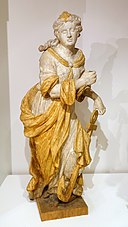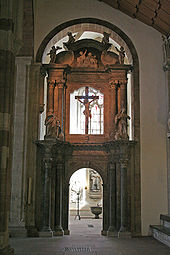Anton Detlev Jenner
Anton Detlev Jenner (* around 1690 in Braunschweig ; † 26. June 1732 ) was a German sculptor and carver of Baroque . He is considered the most important Braunschweig sculptor in the first half of the 18th century. In addition to his three art-historically significant high altars for Braunschweig churches, he created other works of art on buildings, tombs and smaller works.
Life
Jenner was born around 1690 in Braunschweig. He received the citizenship of the city of Braunschweig on October 9, 1720 , but was certainly already in the city before. Around 1724 he married Anna Elenore Seeliger, who gave birth to two daughters and a son Phillipp Gottfried (1724–1773), who later worked as a sculptor in Potsdam and died in 1773 in Braunschweig.
As his first work in 1709 he created the barrier in front of the lay altar in the Brothers Church . He worked for civil and ecclesiastical clients and there is evidence that he has worked for the ducal court in Braunschweig since 1714. In addition to the baroque high altars for several Brunswick churches (see works), Jenner created gate gables, banisters, choir screens and grave monuments. The latter were often supplemented by portraits created by the portrait painter Christoph Bernhard Francke († 1729).
Jenner died in Braunschweig in 1732 and was buried in the Magnifriedhof there.
Works
High altars in Braunschweig
Jenner made three high altars in Braunschweig. The main work is located in the Martinikirche . All three altars have in common the typically crafted bandwork made by Jenner and the two-storey structure.
Martini Church
Jenner's main work is the two-storey and completely preserved high altar in the Martinikirche, created between 1722 and 1725 from alabaster from Nordhausen in the Harz Mountains with a back lining from Elm limestone . It has two side passages. On both sides of the lower communion relief in the middle field there are almost life-size figures of Moses with a staff and tablets of the law and Isaiah with a banner. In the upper middle field the crucified one is shown with the four evangelists . Above is a resurrection scene . Other small, flat reliefs on the basement beams show scenes from the Old Testament , such as the sacrifice of Isaac , the brazen serpent and Jacob is given Joseph's bloody robe. The columns are designed in the Ionic style and connected with round arches.
Jenner had committed himself with all his fortune to make the high altar, which was a very common contractual term at that time. 2,000 thalers were agreed for the entire work. After completion of the first floor he should receive 500 thalers and the rest after completion and acceptance. He had made a mistake about the costs and had to make an additional claim of 500 thalers, of which at least 200 thalers were granted retrospectively. This delayed the completion because Jenner had to prepay the stone materials, wages and transport costs and was in financial difficulties, so the factory could not be inaugurated until February 2, 1725.
Brunswick Cathedral
The baroque high altar in Braunschweig Cathedral was made of wood in 1727 and 1728. Its overall layout resembles that in the Martini church. On the entablature, from the left, stood the virtue of hope with anchor, John the Baptist with lamb, Moses with the tablets of the law, Aaron in priestly robe and the virtue of faith with a cross. The pictures were by Johann Luhn and Magnus de Quitter . The position of the pillars was across the corner, creating a cranked entablature that jumps back and forth. This creates lowered screens that are deeper than the passages. The kneeling angels weren't from Jenner. The altar was demolished between 1886 and 1896 when the interior of the cathedral was renovated. Parts are exhibited in the Braunschweigisches Landesmuseum .
Magni Church
The alabaster high altar for the Magni Church was started in 1730. As with the other two altars, the middle of the altar was two-storeyed in the same width, but the second storey was lower. The main floor with the high relief with the Mount of Olives scene is decorated with two angels. The upper floor showed the crucified, the virtue of hope with anchor and patience with lamb, as well as four angels seated on the entablature.
The altar cost a total of 1,640 thalers. Jenner received 400 thalers on December 4, 1730 for building materials for the new altar building, and 100 thalers each on October 15 and further on November 14. What has also been preserved is that Jenner had signed a delivery contract with sculptor Johann Erhard Beyer from Blankenburg for three workpieces, each weighing 18.5, 16 and 12 hundredweight, made of alabaster from Rübeland in the southern Harz region. Jenner had created about half of the figures, the others are probably attributable to Matthäus Heinrich Vetten . Completion was also delayed here, but this time due to Jenner's illness. After Jenner's death in 1732, the altar was completed in 1733 by Vetten, who had married Jenner's widow. The inauguration took place on May 9, 1734 with a sermon by the general manager Stiffer, who received 12 thalers for this.
The altar was not only relocated from its original location, but also dismantled into two parts and parts of the altar are today (2008) in the south aisle.
Other works
Tombs
- Grave plaque, which the Brunswick Infantry Lieutenant Christoph von Werthern had his wife Anna Elisabeth († February 17, 1703) put up in the St. Andrew's Church with 18 ancestral coats of arms.
- Grave monument of the Chancellor Philipp Ludwig Probst von Wendhausen († 1718) in the Brunswick Cathedral
- Grave monument of Major General Johann Caspar von Völcker († September 10, 1730) and his wife Anna Catharina in Brunswick Cathedral
- Tomb of the canon and privy councilor Julius Basilius Pape († September 10, 1727) in Brunswick Cathedral
- Tomb of Colonel Jacob Rhetz († May 12, 1719) in Katharinenkirche made of alabaster
- Tomb of Colonel Simon Haken († February 19, 1711) in St. Catherine's Church made of wood
- Tomb of the Prussian major general Georg Joachim von der Wense († August 3, 1725 in Mecklenburg) made of wood and a wooden sarcophagus, buried in the Protestant church in Hattorf on February 17, 1726
- Tomb of the businessman Heinrich Christian Schönermark († November 19, 1729) and his wife Anna Sophie Gösner († April 16, 1719)
- Tomb of the princely clerk Friedrich Moritz zu Wrisbergen († April 3, 1719) on the south side of the Katharinenkirche
- Tomb of pastor Heinrich Petri for his three daughters and the son of his sister Theodor Johannes Bentheim († 1715)
- Tomb of the monastery councilor Johannes Justus Voigt († July 17, 1724) in the monastery church Riddagshausen
- Tomb of Julius Gottfried Schlueter and for his wife Anna Sophie, geb. Ridder († March 3, 1729) in the Martinifriedhof
Furthermore, other smaller tombs and grave monuments in Braunschweig correspond to his style. Jenner also carried out simple stone carvings, such as B. a stone with an inscription and border or the renewal of an inscription that is documented.
Busts, baptismal stands, gates, stairs
- Alabaster bust for Salzdahlum Castle near Wolfenbüttel (1729)
- A portrait relief of the Privy Councilor of Imhof († July 21, 1717) was the only one of the epitaphs from the Baroque period of the Nikolaikirche to be preserved after the outer walls were repaired in 1873
- Baptismal stand in the church of Gittelde made of wood
- Staircase parapet of the ducal armory, formerly Paulinerkirche (1712)
- Gate gable fittings of the August Middle School (1711)
- Door gable fittings in Neue Straße 26 made of wood
- Door gable fittings of the former Hotel d 'Angleterre at Breiten Straße 18 (1716)
literature
- Georg Dehio : Handbook of German Art Monuments, Bremen / Lower Saxony , Deutscher Kunstverlag 1977
- Horst-Rüdiger Jarck (Ed.): Braunschweigisches Biographisches Lexikon. 8th to 18th centuries , page 375, Braunschweig 2006, ISBN 3-937664-46-7
- Rainer Maaß: Jenner, Anton Detlev in: Braunschweiger Stadtlexikon , supplementary volume, p. 141, Braunschweig 1996, ISBN 3-926701-30-7
- Paul Jonas Meier : The sculptor's handicrafts in the city of Braunschweig since the Reformation. In: Workpieces from the museum, archive and library of the City of Braunschweig VIII., Appelhans, Braunschweig 1936.
Web links
Individual evidence
- ↑ Paul Jonas Meier: Kunsthandwerk, p. 94 (see literature)
- ↑ At the Magnikirche these are the smaller tombs of Johann Georg Schmidt († May 16, 1717) and his wife Catharine Dorothea von Bergen († August 1726) and of Johann Georg Petzel († October 8, 1732) and his daughter Dorothea Margarethe Widderen († July 1739). Quoted from Paul Jonas Meier: Kunsthandwerk, p. 99 (see literature)
- ↑ Paul Jonas Meier: Kunsthandwerk, p. 100 (see literature)
| personal data | |
|---|---|
| SURNAME | Jenner, Anton Detlev |
| ALTERNATIVE NAMES | Jenner, Anton Detlef |
| BRIEF DESCRIPTION | German sculptor and carver |
| DATE OF BIRTH | around 1690 |
| PLACE OF BIRTH | Braunschweig |
| DATE OF DEATH | June 26, 1732 |
| Place of death | Braunschweig |


